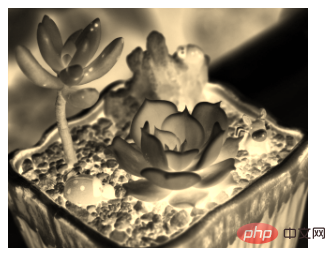How to change the color of png images with css
You can use the filter attribute in css with the invert(), grayscale(), sepia() or hue-rotate() functions to change the png color; hue-rotate() sets the hue rotation, and grayscale() adjusts the gray degree, sepia() sets the sepia image.

The operating environment of this tutorial: Windows 7 system, CSS3&&HTML5 version, Dell G3 computer.
You can use the Filter attribute in CSS to use the filter function to change the color of the image; the Filter attribute of CSS is mainly used to set the visual effect of the image.
The filter attribute defines the visual effect of the element (usually  ). This attribute is mainly used for image content.
). This attribute is mainly used for image content.
This attribute is a CSS method that applies filter effects to elements (mainly images) on the web page.
Related attribute values:
grayscale(): Sets the grayscale of the element, which converts the element color to black and white. Grayscale 0% represents the original element, and 100% represents the completely grayscale element.
sepia(): It converts the image to a sepia image, where 0% means the original image and 100% means full sepia.
hue-rotate(): It applies hue rotation to the image. This value defines the degree around which the color circle of the image sample will be adjusted. The default value is 0deg, which represents the original image; although this value has no maximum value, a value exceeding 360deg is equivalent to going around again.
invert(): It inverts the elements. The default value is 0%, which represents the original image. 100% makes the image completely inverted.
Code example: Use the filter attribute to change the image color
<!DOCTYPE HTML>
<html>
<head>
<meta charset="UTF-8">
<style type="text/css">
img {
width: 300px;
}
.img1 {
/*元素的灰度*/
/*考虑浏览器兼容性:兼容Chrome,Safari,Opera*/
-webkit-filter: grayscale(100%);
filter: grayscale(100%);
}
.img2 {
/*将图像转换为棕褐色图像*/
/*考虑浏览器兼容性:兼容Chrome,Safari,Opera*/
-webkit-filter: sepia(100%);
filter: sepia(100%);
}
.img3 {
/*色调旋转*/
/*考虑浏览器兼容性:兼容Chrome,Safari,Opera*/
-webkit-filter: hue-rotate(55deg);
filter: hue-rotate(55deg);
}
.img4 {
/*反转元素*/
/*考虑浏览器兼容性:兼容Chrome,Safari,Opera*/
-webkit-filter: invert(100%);
filter: invert(100%);
}
</style>
</head>
<body>
<div class="demo">原图:<br />
<img src="/static/imghw/default1.png" data-src="img/1.jpg" class="lazy" / alt="How to change the color of png images with css" >
</div><br /><br />
<div class="demo">应用滤镜,改变颜色后:<br />
<img class="img1 lazy" src="/static/imghw/default1.png" data-src="img/1.jpg" / alt="How to change the color of png images with css" >
<img class="img2 lazy" src="/static/imghw/default1.png" data-src="img/1.jpg" / alt="How to change the color of png images with css" >
<img class="img3 lazy" src="/static/imghw/default1.png" data-src="img/1.jpg" / alt="How to change the color of png images with css" >
<img class="img4 lazy" src="/static/imghw/default1.png" data-src="img/1.jpg" / alt="How to change the color of png images with css" >
</div>
</body>
</html>Rendering:

Example 2: This example uses many filters on the image
<!DOCTYPE html>
<html>
<head>
<meta charset="UTF-8">
<title>将图像转换为不同的颜色</title>
<style>
img {
float:left;
-webkit-filter: invert(100%) sepia(100%);
filter: invert(100%) sepia(100%);
}
</style>
</head>
<body>
<img src="/static/imghw/default1.png" data-src="img/1.jpg" class="lazy" style="max-width:90%"/ alt="How to change the color of png images with css" >
</body>
</body>
</html> Rendering:

Description: Use multiple filters, each filter Use spaces to separate
(Learning video sharing: css video tutorial)
The above is the detailed content of How to change the color of png images with css. For more information, please follow other related articles on the PHP Chinese website!

Hot AI Tools

Undresser.AI Undress
AI-powered app for creating realistic nude photos

AI Clothes Remover
Online AI tool for removing clothes from photos.

Undress AI Tool
Undress images for free

Clothoff.io
AI clothes remover

AI Hentai Generator
Generate AI Hentai for free.

Hot Article

Hot Tools

Notepad++7.3.1
Easy-to-use and free code editor

SublimeText3 Chinese version
Chinese version, very easy to use

Zend Studio 13.0.1
Powerful PHP integrated development environment

Dreamweaver CS6
Visual web development tools

SublimeText3 Mac version
God-level code editing software (SublimeText3)

Hot Topics
 What does placeholder mean in vue
May 07, 2024 am 09:57 AM
What does placeholder mean in vue
May 07, 2024 am 09:57 AM
In Vue.js, the placeholder attribute specifies the placeholder text of the input element, which is displayed when the user has not entered content, provides input tips or examples, and improves form accessibility. Its usage is to set the placeholder attribute on the input element and customize the appearance using CSS. Best practices include being relevant to the input, being short and clear, avoiding default text, and considering accessibility.
 What does span mean in js
May 06, 2024 am 11:42 AM
What does span mean in js
May 06, 2024 am 11:42 AM
The span tag can add styles, attributes, or behaviors to text. It is used to: add styles, such as color and font size. Set attributes such as id, class, etc. Associated behaviors such as clicks, hovers, etc. Mark text for further processing or citation.
 What does rem mean in js
May 06, 2024 am 11:30 AM
What does rem mean in js
May 06, 2024 am 11:30 AM
REM in CSS is a relative unit relative to the font size of the root element (html). It has the following characteristics: relative to the root element font size, not affected by the parent element. When the root element's font size changes, elements using REM will adjust accordingly. Can be used with any CSS property. Advantages of using REM include: Responsiveness: Keep text readable on different devices and screen sizes. Consistency: Make sure font sizes are consistent throughout your website. Scalability: Easily change the global font size by adjusting the root element font size.
 How to introduce images into vue
May 02, 2024 pm 10:48 PM
How to introduce images into vue
May 02, 2024 pm 10:48 PM
There are five ways to introduce images in Vue: through URL, require function, static file, v-bind directive and CSS background image. Dynamic images can be handled in Vue's computed properties or listeners, and bundled tools can be used to optimize image loading. Make sure the path is correct otherwise a loading error will appear.
 What is node in js
May 07, 2024 pm 09:06 PM
What is node in js
May 07, 2024 pm 09:06 PM
Nodes are entities in the JavaScript DOM that represent HTML elements. They represent a specific element in the page and can be used to access and manipulate that element. Common node types include element nodes, text nodes, comment nodes, and document nodes. Through DOM methods such as getElementById(), you can access nodes and operate on them, including modifying properties, adding/removing child nodes, inserting/replacing nodes, and cloning nodes. Node traversal helps navigate within the DOM structure. Nodes are useful for dynamically creating page content, event handling, animation, and data binding.
 What language is the browser plug-in written in?
May 08, 2024 pm 09:36 PM
What language is the browser plug-in written in?
May 08, 2024 pm 09:36 PM
Browser plug-ins are usually written in the following languages: Front-end languages: JavaScript, HTML, CSS Back-end languages: C++, Rust, WebAssembly Other languages: Python, Java
 How to set unknown attributes in vscode vscode method to set unknown attributes
May 09, 2024 pm 02:43 PM
How to set unknown attributes in vscode vscode method to set unknown attributes
May 09, 2024 pm 02:43 PM
1. First, open the settings icon in the lower left corner and click the settings option. 2. Then, find the CSS column in the jumped window. 3. Finally, change the drop-down option in the unknownproperties menu to the error button.
 What do ref and id in vue do?
May 02, 2024 pm 08:42 PM
What do ref and id in vue do?
May 02, 2024 pm 08:42 PM
In Vue.js, ref is used in JavaScript to reference a DOM element (accessible to subcomponents and the DOM element itself), while id is used to set the HTML id attribute (can be used for CSS styling, HTML markup, and JavaScript lookup).






